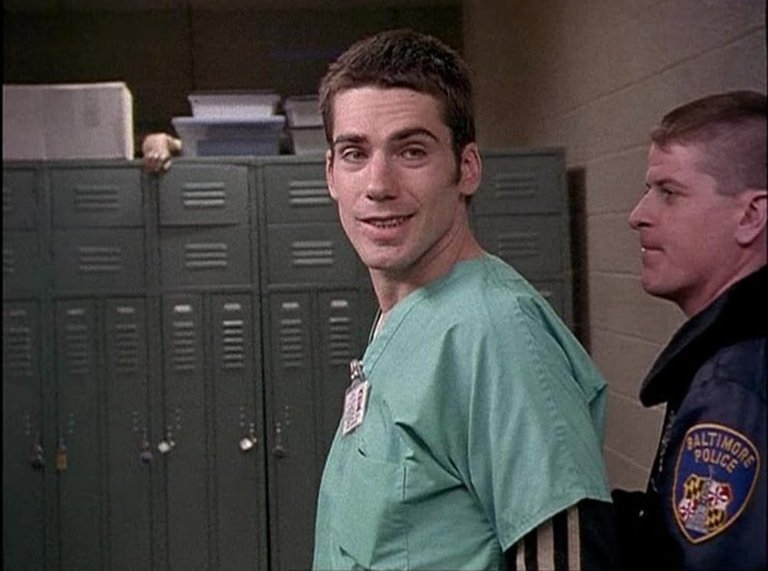
Diener (S05E14)
Airdate: 31 January 1997
Written by: Christopher Kyle
Directed by: Kyle Secor
Running Time: 46 minutes
The later seasons of Homicide: Life on the Street often left original fans disillusioned, as the show’s gritty, unvarnished portrayal of police work gradually gave way to slicker, more conventional narrative tropes. By its fifth season, the series had strayed from the raw, documentary-like realism that defined its early years, opting instead for heightened drama and character arcs that prioritized Hollywood appeal over the unflinching authenticity that once made it a landmark of ’90s television. Among these middling later entries, Diener—a Season 5 episode directed by regular cast member Kyle Secor—stands as a case of potential squandered. While competently executed, it feels like a half-finished idea, a missed opportunity to explore the show’s themes with the depth it once commanded.
In Diener Kyle Secor, known for his role as Detective Tim Bayliss, making his directorial debut—a role that might have led audiences to expect Bayliss to anchor the episode. Instead, Secor spreads his focus across multiple subplots, with Bayliss relegated to a minor role. The detective’s storyline revolves around his strained relationship with Frank Pembleton, his former partner of four years, whose partnership recently dissolved. Now paired with Meldrick Lewis, Pembleton’s personal life is unraveling as well; his wife, Mary, confronts him about the toll his job is taking on their marriage. Mary’s ultimatum—to reunite with Bayliss—culminates in a scene where she pleads with Bayliss to take Pembleton back. Though Bayliss agrees reluctantly, the subplot feels underexplored, a mere tease of the complex dynamics between the two characters that the show had previously mined so effectively.
Meanwhile, Lewis’s temporary partnership with Pembleton is framed as a pragmatic solution: Detective Kellerman, his usual partner, is on leave after a recent breakdown that nearly cost him his life. The writers wisely use this to hint at Kellerman’s vulnerability, with a private conversation between him and Lewis revealing that he’s now seeing a therapist. This quiet moment adds texture to Kellerman’s character, suggesting a man grappling with the emotional scars of his job—a theme Homicide often balanced with surgical precision. Yet the episode’s fragmented structure prevents these threads from coalescing into something resonant.
The main narrative follows Pembleton and Lewis investigating the murder of Mrs. Bridgewell, a wealthy arts patron found bludgeoned in her home. The case serves as a platform for the duo’s contrasting approaches: Lewis suspects a Black suspect linked to the city’s underprivileged youth, while Pembleton zeroes in on the victim’s brother, Charles Matheny’s character, who had a history of conflict with her. Though the brother’s gult seems more compelling, the plot hinges on a missing diamond ring, a key piece of evidence that vanishes from the crime scene. The resolution, when it comes, is both clever and anticlimactic: the ring is revealed to have been stolen by the medical examiner’s diener (a term for an assistant), Jeff McGinn, played by Glenn Fitzgerald. Dr. Cox, the medical examiner, grows suspicious of Jeff and, with the help of Detective Brodie, sets up a camera to catch him in the act. Yet the episode’s climax undercuts its own tension: the ring is pawned and lost, leaving the case’s outcome in doubt—a neat twist that feels more like a narrative shrug than a meaningful commentary on institutional failure.
The episode’s greatest strength lies in its script by Christopher Kyle, which attempts to broaden Homicide’s scope beyond the Homicide Unit. By shifting focus to the morgue, the story highlights the systemic flaws permeating the entire police apparatus, suggesting that ethical compromises and human fallibility extend far beyond the detectives’ desks. Jeff McGinn’s arc, though brief, offers a glimpse into the pressures faced by low-level employees in a bureaucracy riddled with corruption. Fitzgerald’s performance is understated and sympathetic, making Jeff’s descent into theft plausible rather than cartoonish. However, the character’s introduction is rushed, his motivations thinly sketched. Had he been established as a recurring figure in earlier episodes, his betrayal might have carried more weight. Instead, the revelation feels like a contrivance—a mystery solved too quickly, its implications left unexplored.
Secor’s direction is serviceable if unremarkable, balancing the multiple storylines with a steady hand. His choice to frame the morgue scenes with a clinical, almost sterile aesthetic contrasts effectively with the grime of the streets, underscoring the episode’s theme of institutional decay. Yet the pacing falters: the Bayliss-Pembleton subplot lingers too long without payoff, while the murder investigation drags in the middle, its tension dissipated by redundant dialogue. Secor’s debut effort is competent, but it lacks the sharpness that defined Homicide’s best episodes, where every frame felt purposeful.
Ultimately, Diener is a frustratingly uneven episode. Its strengths—a nuanced script, solid acting, and a willingness to interrogate the rot beneath the police system’s facade—are overshadowed by its structural flaws. The unresolved ending, while clever, feels like a cop-out, avoiding the moral complexity that once defined the show’s approach to crime and justice. The decision to centre Jeff McGinn as the villain, while inventive, is undercut by his underdevelopment, reducing a potentially rich exploration of institutional corruption to a procedural plot twist.
Fans of the series will recognize Diener as emblematic of Homicide’s later seasons: a show still capable of flashes of brilliance, but hamstrung by its own ambition and the compromises of network television. It’s a reminder of what the show could have been—a deeper dive into the lives of those often overlooked in police narratives—but also a testament to how easily its legacy was diluted by the very changes it resisted.
RATING: 6/10 (++)
Blog in Croatian https://draxblog.com
Blog in English https://draxreview.wordpress.com/
InLeo blog https://inleo.io/@drax.leo
Hiveonboard: https://hiveonboard.com?ref=drax
Rising Star game: https://www.risingstargame.com?referrer=drax
1Inch: https://1inch.exchange/#/r/0x83823d8CCB74F828148258BB4457642124b1328e
BTC donations: 1EWxiMiP6iiG9rger3NuUSd6HByaxQWafG
ETH donations: 0xB305F144323b99e6f8b1d66f5D7DE78B498C32A7
BCH donations: qpvxw0jax79lhmvlgcldkzpqanf03r9cjv8y6gtmk9